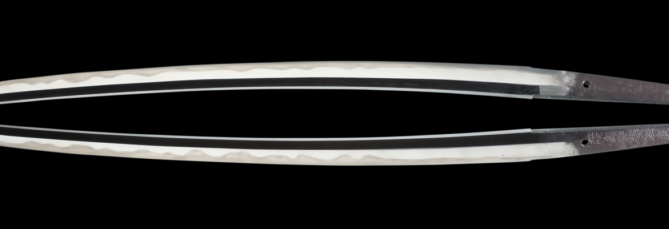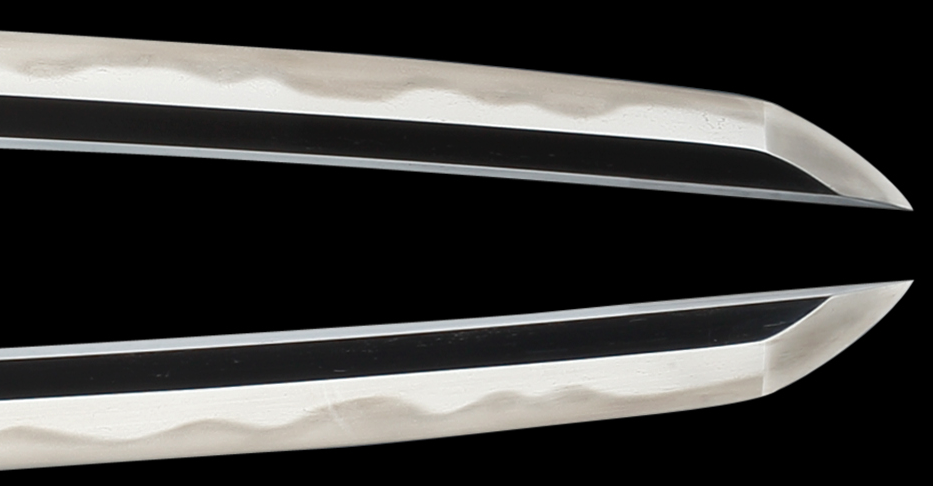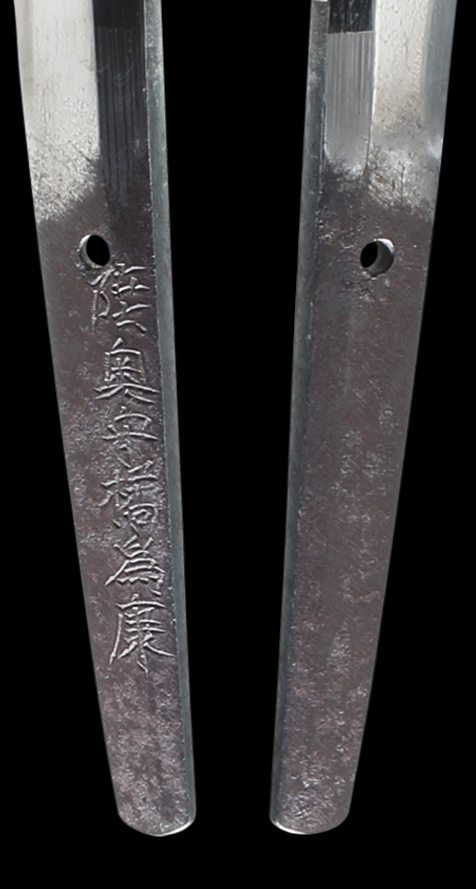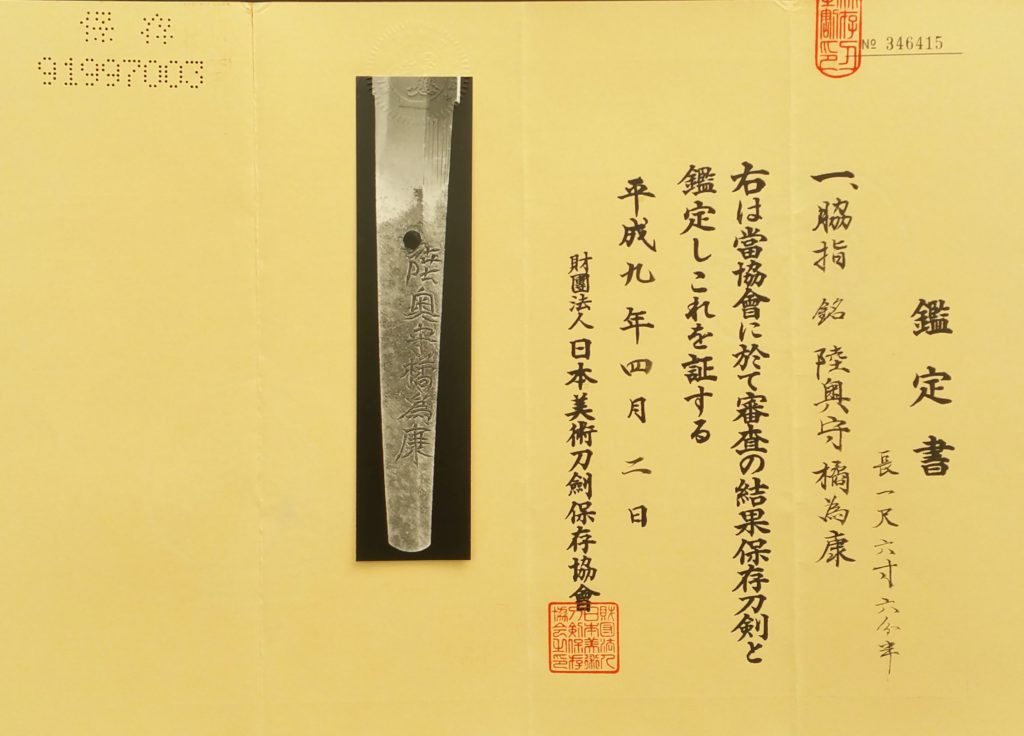一般情報 General information
| 製品番号 Product No. | WA-005 (爲康)Tameyasu. 2e Generation. |
| 剣の種類 Sword type | 脇差 Wakizashi. |
| 銘 MEI (表 Omote) | 陸奥守橘爲康 Mutsu (no) kami Tachibana Tameyasu. |
| 銘 MEI (裏 Ura) | 適用外です Not applicable |
| 時代 Era | 延宝 Enpō period. 1673-1680. |
| 日付 Date | ca. 1675. |
| 州 Province | 紀伊 Kii. |
| 伝 School | 紀伊石戸 Kii Ishido. |
| 師 Teacher | 康廣(紀伊國康廣) 1e Generation Yasuhiro (Kiinokuni Yasuhiro) who was the founder of Kii Ishido school. |
寸法 Measurements
| 長さ Nagasa | 50.6 cm |
| 反り Sori | 1.30 cm |
| 元幅 Motohaba | 3.06 cm |
| 先幅 Sakihaba | 2.02 cm |
| 重ね Kasane | 0.81 cm |
| 中子 Nakago | 15.4 cm |
鑑定書 Kantei-sho
| 日本美術刀剣保存協会 NBTHK Certificate | 保存刀剣 Hozon tōken |
| 他の証明書 Other certificate | 適用外です Not applicable |
| 考課 Appraisal 鑑定 Kantei | 上作 Jyo Saku. Rating by Hawley 15 points. |
| 状態 Status | 上等 Superior. |
| 研磨 Polish | 平均研磨上記 above average polishing. |
| 切れ味の分類 Classification on sharpness | 業物 Wazamono. |
詳細 Details
| 姿 Sugata | Shinogi-zukuri, Iori-mune, sharply rounded (fukura-tsuku), Torii-sori. |
| 肌 Hada | Mokume, with Utsuri. Ko-itame hada with itama and masame. |
| 切先 Kissaki | Chu kissaki. |
| 刃文 Hamon | Gunome choji, O-notare toran, nie-deki. |
| 彫物 Horimone | 適用外です Not applicable |
| 帽子 Bōshi | Hkikakete kaeru |
| 中心 Nakago | Ubu, keitai, yasurime, nakagojiri, kurijiri. |
| 目釘穴 Mekugi-ana | 1 mekugi ana. |
| はばき Habaki | Nice copper bases, single gold folded Habaki. |
| 外装 Koshirae | A very nice Kohsirae and sword fittings. All stored in an old/antique silk bag. |
| 自鞘 Shira-saya | The blade is polished and stored in a nice Shirasaya with a purple-coloured silk bag. |
| 追加情報 Additional Information | The judgment on the authentic as expressed in the description above was confirmed by “Nippon Bijutsu Tōken Hozon Kyokai” (NBTHK) issuing a 保存刀剣 Hozon tōken certificate: number 346415Provided on 平成九年四月二日. Heisei kȗ nen shi gatsu ni hi, April 2th, 1998.
TAMEYASU (為康), 2nd gen., oldest son of the 1st gen. Tameyasu, older brother of Bitchū no Kami Yasuhiro (備中守康広), he moved later to Ōsaka and worked in the style of his father, flamboyant ōbusa-chōji, gunome, but the bōshi is mostly sugu, wazamono, chūjō-saku |
| 歴史 History | During the early years of the Edo period (Kanei Era 1624-1644), the various groups of smiths who made up the Ishido Kei left Omi and split into three groups. These three groups moved to Edo (Musashi Province), Wakayama (Kii Province), and Fukuoka (Chikuzen Province) then founded own schools.Mutsu no kami Tachibana Tameyasu 陸奥守橘為康, real name Tomita Gorozaemon 富田五郎左衛門 who learned under his father – 1e Gen. Yasuhiro (Kiinokuni Yasuhiro) 康廣(紀伊國康廣)who was the founder of Kii Ishido school. They worked in Waakayama castle city first then moved to Settu (Osaka).
The second generation Tameyasu first named himself “Bishu no Kami Tachibana (no) Tameyasu 備中守橘為康” then” Tosa Shogen Tachibana (no) Yasuhiro 土佐将監橘康廣“, later “Mutsuno Kami Tachibana (no) Tameyasu 陸奥守橘為康“ after given a title “Mutsuno Kami” by the Shogunate. This is a superb work of “Mutsu no Kami Tameyasu” with a beautiful Choji Homon which resembles to Ichimonji in the ancient period. |
価格 price € 8950,– (Shipping fee is not included in the price).
PS: More photos available on request!






